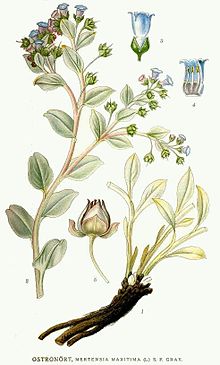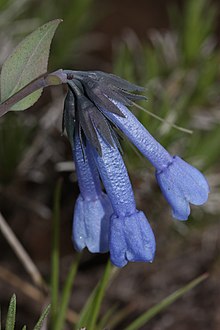Mertensia
| Mertensia | ||||||||||||
|---|---|---|---|---|---|---|---|---|---|---|---|---|

|
||||||||||||
| Systematics | ||||||||||||
|
||||||||||||
| Scientific name | ||||||||||||
| Mertensia | ||||||||||||
| Roth |
Mertensia even Bluebells is called a genus within the family of Borage Family (Boraginaceae). The 40 to 60 species in the northern hemisphere, both in North America and in northern Asia, with one species also in northern Europe, distributed. The varieties of some species are used as ornamental plants in parks and gardensbecause of their attractive flowers.
description


Vegetative characteristics
Mertensia species are perennial herbaceous plants . They sprout individually or in groups from a perennial, sometimes somewhat woody rhizome . The vegetative parts of the plant are coarse hairy or, as an exception in the family, bare. The mostly unbranched stems below the inflorescence are erect or prostrate.
The foliage leaves , arranged in basal rosettes and alternately on the stem, are short-stalked or sessile (sessile). The simple leaf blades are ovate to linear and sometimes heart-shaped.
Generative characteristics
Many flowers are arranged in terminal, zymous inflorescences that are sometimes stretched with age and then resemble a grape . The flowers are above a bract or without one.
The hermaphrodite flowers are five-fold with a double flower envelope . The five sepals are only fused at their base up to a maximum of half their length. The five petals are fused to form a bell-shaped corolla that is blue, rarely white or reddish in color. The cylindrical to funnel-shaped grain tube is longer than the calyx. At the throat, the transition from the corolla tube to the expanded corolla lobes, the entrance to the tube is narrowed by turned-in folds or rarely by inconspicuous scales. The spreading corolla lobes are rounded to ovate, with a blunt apex. The stamens are fused with the corolla tube, the stamens are short, the anthers are longer and in many species protrude from the flower. The ovary into four parts, with vorragendem from the flower or trapped in this pen , in some species there are two or three different lengths before ( Heterostylie ).
The Klausen fruit breaks down into four partial fruits (Klausen). The four-sided, rough, bald clauses are rounded on the inside, sharply edged on the outside and sometimes keeled.
distribution

The species of the genus Mertensia are distributed in the northern hemisphere in temperate North America and temperate Eurasia. In Asia, the main distribution area is in northeastern Siberia ( Beringia ), with six species in China. In North America, the genus is predominantly, with numerous endemic species, in the mountain ranges in the west ( Rocky Mountains ), north to Alaska, with most species in Colorado . Few species are also found in forests in the northeast of the continent. One species, Mertensia maritima , is widespread along the sea coasts in both Eurasia and North America (circumboreal); it also occurs on the coasts of Northern Europe (Scandinavia, Great Britain, Ireland, Iceland).
According to the genetic data, the center of origin of the genus Mertensia is probably northern Asia, although most of the species occur in western North America.
Systematics
The genus Mertensia was established in 1797 by the German botanist Albrecht Wilhelm Roth in the first volume of his work Catalecta botanica quibus plantae novae et minus cognitae describuntur atque illustrantur . The genus name Mertensia honors the German botanist and plant collector Franz Karl Mertens (1764-1831). The type species is Mertensia pulmonarioides , today a synonym for Mertensia virginica . Three species of the genus, Mertensia virginica , Mertensia maritima and Mertensia sibirica , were first described by Carl von Linné as species of the genus Pulmonaria . The genus Pneumaria, established by the English botanist John Hill in 1764 with the type species Mertensia maritima , would have priority, but the name was suppressed by the ICBN .
The position of the genus Mertensia within the Boraginaceae family was for a long time uncertain and controversial based on morphological characteristics. It was temporarily assigned to the tribes Symphyteae, Lithospermeae, Eritrichieae, Trigonotideae and Cynoglosseae. Genetic studies were carried out which revealed the monophyly of the genus Mertensia . By Chacón et al. In 2016 the genus Mertensia was classified in the tribe Asperugeae in the newly established subfamily Cynoglossoideae within the family Boraginaceae . Within the Asperugeae tribe, Mertensia is closest related to the sister taxon Anoplocaryum , a genus comprising five Central Asian species. The tribe Asperugeae also includes the two monotypic genera Memoremea with the only species of forest umbilicalus ( Memoremea scorpioides ), which was separated from the genus Omphalodes , and Asperugo with the only species of hawkweed ( Asperugo procumbens ).
The genus Mertensia partly includes cryptic species that are difficult to distinguish morphologically or not at all , which can also hybridize with one another. The number of species is therefore uncertain.
The genus Mertensia is divided into sections.
There are 40 to 60 species of Mertensia (selection):
- Mertensia arizonica Greene : It occurs in the US states of Colorado , Wyoming and Utah .
- Mertensia bella Piper : It occurs in the US states of California , southwest Oregon , northern Idaho , northwest Montana .
- Mertensia brevistyla S. Watson
- Mertensia ciliata (E. James ex Torr.) G.Don : It occurs in the US states of Colorado, Idaho , Montana , Oregon , Wyoming, California , Nevada , Utah and New Mexico .
- Mertensia cusickii Piper : It occurs in the US states of California , southwest Oregon, southwest Idaho, central Nevada.
- Mertensia franciscana A. Heller
- Mertensia longiflora Greene : It occurs in western North America in British Columbia , California and Montana.
- Coastal bluebells , oyster plant , horse 's tongue ( Mertensia maritima (L.) Gray ): It is found in the northern hemisphere in Northern Europe , Eastern Europe and from Siberia , Korea , Japan over Russia's Far East to Alaska , Canada and in the US states Maine , Massachusetts as well as New Hampshire widespread.
- Mertensia oblongifolia (Nutt.) G.Don : In the western United States it is only found in North Dakota and South Dakota .
- Mertensia paniculata (Aiton) G.Don : It is found in Alaska, Canada, Idaho, Montana, Michigan and New Mexico.
- Mertensia pterocarpa (Turcz.) Tatew. & Ohwi : It occurs in Japan and Sakhalin .
- Mertensia sibirica (L.) G.Don : It occurs in Russia's Far East, in Siberia and in China.
- Virginian blue of the valley ( Mertensia virginica (L.) Pers. Ex Link ): It occurs in Québec , Canada and Ontario, and in the eastern and north-central United States.
Use as ornamental plants
Some species in the genus are used as ornamental plants because of their attractive blue flowers. The species used for this belong to the early bloomers and are often used on acidic, humus-rich soils in the shade of trees, as forest shrubs. They are rather rare in Europe, often in larger parks. The problem with the culture is their susceptibility to snail damage. The most common species are Mertensia virginica (known as an ornamental plant of the Virginian blue-valley) and Mertensia sibirica .
Individual evidence
- ↑ a b Gelin Zhu, Harald Riedl, Rudolf V. Kamelin: In: Wu Zheng-yi, Peter H. Raven (Ed.): Flora of China , Volume 16: Gentianaceae through Boraginaceae. Science Press and Missouri Botanical Garden Press, Beijing and St. Louis 1995, ISBN 0-915279-33-9 . Mertensia Roth. Pp. 375–377 - the same text online as the printed work.
- ^ JW Franks: Mertensia. In TG Tutin, VH Heywood, NA Burges, DH Valentine, PW Ball, SM Walters, AO Chater, DA Webb, RA DeFilipps, IK Ferguson, IBK Richardson (eds.): Flora Europaea. Volume 3: Diapesiaceae to Myoporaceae. Cambridge University Press, 1972. ISBN 0-521-08489-X . Pp. 109-110.
- ^ Joachim W. Kadereit, Volker Bittrich: The Families and Genera of vascular Plants. Volume XIV: Eudicots: Aquifoliales, Boraginales, Bruniales, Dipsacales, Escalloniales, Garryales, Paracryphiales, Solanales (except Convolvulaceae), Icacinaceae, Metteniusaceae, Vahliaceae. Springer International Publishing, Switzerland 2016, ISBN 978-3-319-28532-0 , p. 66.
- ↑ Louis Otho Williams: A Monograph of the Genus Mertensia in North America. In: Annals of the Missouri Botanical Garden , Volume 24, Issue 1, 1937, pp. 17-159. JSTOR 2394213
- ↑ a b c d e Ronald B. Kelley, Elaine Joyal, 2012: Ronald B. Kelley, Elaine Joyal 2012: Datasheet Mertensia, Bluebell in Jepson Flora Project (Ed.): Jepson eFlora , The Jepson Herbarium, University of California, Berkeley , last accessed on July 26, 2020.
- ^ A b c Mare Nazaire, Xiao-Quan Wang, Larry Hufford: Geographic Origin and Patterns of Radiation of Mertensia (Boraginaceae). In: American Journal of Botany , Volume 101, Issue 1, 2014, pp. 104-118. doi : 10.1600 / 036364414X678107
- ↑ a b Tomoko Fukuda, Hiroshi Ikeda: Palynological analysis and taxonomic position of the genus Mertensia (Boraginaceae). In: Botany , Volume 90, Issue 8, August 2012, pp. 722-730. doi : 10.1139 / b2012-024
- ^ Mare Nazaire, Larry Hufford: A Broad Phylogenetic Analysis of Boraginaceae: Implications for the Relationships of Mertensia. In: Systematic Botany , Volume 37, Issue 3, September 2012, pp. 758-783. doi: 10.1600 / 036364412X648715
- ↑ a b c Juliana Chacón, Federico Luebert, Hartmut H. Hilger, Svetlana Ovchinnikova, Federico Selvi, Lorenzo Cecchi, C. Matt Guilliams, Kristen Hasenstab-Lehman, Karel Sutorý, Michael G. Simpson, Maximilian Weigend: The borage family (Boraginaceae s. str.): A revised infrafamilial classification based on new phylogenetic evidence, with emphasis on the placement of some enigmatic genera. In: Taxon , Volume 65, Issue 3, 2016, pp. 523-546. doi: 10.12705 / 653.6 PDF.
- ↑ a b c d e f g h i Mertensia in the Germplasm Resources Information Network (GRIN), USDA , ARS , National Genetic Resources Program. National Germplasm Resources Laboratory, Beltsville, Maryland. Retrieved July 20, 2020.
- ↑ Peter Steiger: Blue flowers over rough sheet. The potential of the Boraginaceae as garden perennials. Yearbook of the Society of Swiss Perennial Friends GSS / ASPV 2011 PDF .
Web links
- Mertensia at Tropicos.org. Missouri Botanical Garden, St. Louis, accessed July 23, 2020.
- Thomas Meyer, Michael Hassler: Mediterranean and Alpine flora : data sheet of the wild species in the Mediterranean area with photos.
- USDA data sheet.
further reading
- Shang-Yao Lin, Jessica Forrest: The function of floral orientation in bluebells: Interactions with pollinators and rain in two species of Mertensia (Boraginaceae). In: Journal of Plant Ecology , Volume 12, December 2017, pp. 113–123. doi : 10.1093 / jpe / rtx073
- Mare Nazaire: A Phylogenetic Analysis of the Genus Mertensia (Boraginaceae): Taxonomy, Divergence Times, and Biogeography. , A dissertation submitted in partial fulfillment of the requirements for the degree of DOCTOR OF PHILOSOPHY from Washington State University, 2013, ISBN 978-1-303-24166-6 . PDF. (79.05 Mb)



